|
|
Maritime Topics On Stamps:
|
|
Background information:
In St. Petersburg, on January 21, 1905, Russian police and Cossacks opened fire on a peaceful demonstration
of striking factory workers living in squalid poverty. Approx. 500 workers were killed.
The event, know as ‘Bloody Sunday’, resulted in strikes, rebellion and mutinies across the whole Russian nation.
The entire country was demoralized following the Russian defeat against the Japanese at Tsushima where the complete
Baltic Sea Fleet was sunk.
|
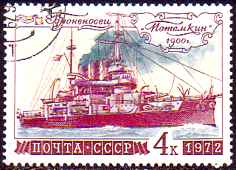
|
Armored cruiser "Potemkin", also "Potjomkin",
exact name "Knjas Potjomkin Tawritscheski" (Prince Potjomkin of Taurien).
1896 ordered, 1898 start of building,
1900 launched,
1904 commissioned; Nikolajew State shipyard.
|
Some data:
LOA 115.3 m, Beam 22 m, Draft 8.5 m
12,580 tons Displacement
10,600 hp, twin screws, 17 kn
Armaments 4 x 30.5 cm, 16 x 15.2 cm, 14 x 7.5 cm, 6 x 4.7 cm guns;
5 torpedo tubes.
Crew 731officers and men
Operatins in the Russian Black Sea Fleet.
|
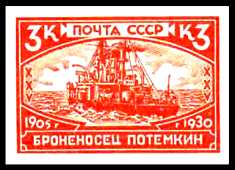
|

|
The sailors of the Russian navy were from the working classes, all the
officers were aristocrats. This led to conflicts, fueled further by the sailors’ low wages.
The Admiral of the Fleet allegedly received 108,000 roubles p.a., a sailor only earned 11 roubles and 55 copecks
as annual salary.
The sailors’ food was extremely bad. Discrimination was rampant; an example: five streets in an upper-class
Odessa neighborhood were declared "off-limits" for the sailors.
| |
On June 25, 1905, "Potemkin" left the port of Sewastopol for
gunnery exercises in the bay of Tendra.
Captain Golikov, called "the dragon", cut the crew’s lunch break in half and cancelled the weekly wash-day
without replacement.
|
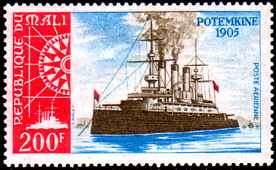
|
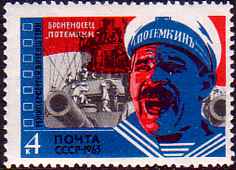
|
The unrest increased on June 27 when the sailors discovered putrid rotten meat hanging from a hook on the upper deck.
At noon time, when the crew refused eating the spoiled meat, the captain ordered all sailors to line up on the afterdeck.
He threatened to hang the rebels from the yardarms. When the situation escalated further, the captain left command to his
chief mate. He threatened to execute 30 sailors with death by firing squad.
|
The sailors defended themselves, a shot was fired. The chief mate presumably shot fireman Vakulincuk,
a known agitator, following a short exchange of words. The crew rushed at the officers,
threw seven of them overboard and locked the others in their quarters.
Other reports state that Vakulincuk fired the first shot.
|
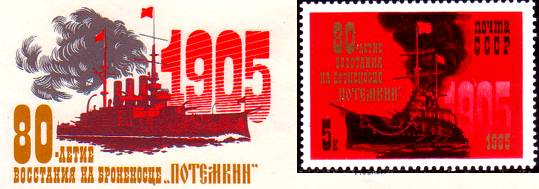
| |
The sailors took over the ship. They formed a committee led by sailor Matjusenko and entered the port of Odessa
with a hoisted red flag. They anchored on the outer roadstead. There was a general strike in Odessa.
There were riots and fights between workers and the police leading to several hundred shot dead.
The city was declared to be under a ’state of siege’.
|
|
Vakulincuk’s casket was brought ashore and laid out at the quay on June
28th. Thousands of striking demonstrators streamed to the port and summoned up new courage.
The sailors of the "Potemkin" had triumphed over the ruling classes. Vakulincuk's burial immediately became a violent,
political demonstration.
The Cossack police retaliated against the strikers, over 500 people were
killed during this day, and some 6,000 workers were killed the
following night. A quarter of the city was up in flames.
|
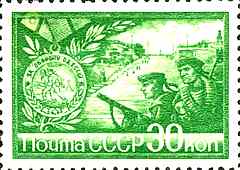
|
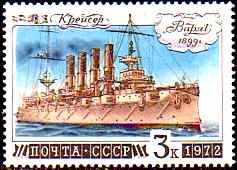
|
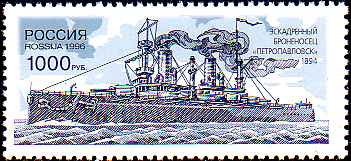
| |
The crew of the "Potemkin" couldn't agree on supporting Odessa’s
demonstrators with a landing maneuver. They are said to have fired two shots. Then they left port.
On June 30, 1905, a fleet of 12 battleships under the command of
Vice Admiral Krieger left Sewastopol to reconquer the "Potemkin". The "Potemkin" approached them head-on.
When they met, the sailors of the squadron refused shooting at their
brothers. The armored cruiser "Grigorij Pobedonoscev" briefly joined the insurgents, but the ship was grounded
by the officers. "Potemkin" fled to the Romanian port of Constanza. Other sources report
"Potemkin" sailed around the Black Sea for a week, before calling at Constanza for lack of coals and provisions.
They couldn't return to Odessa as the rebellion there had collapsed.
Further sources state that "Potemkin" did return to Odessa and departed for Constanza accompanied by the
torpedo-boat #267.
In Constanza the "Potemkin" sailors were refused food and coal.
Then followed an unsuccessful attempt in Feodossja and they returned again to Constanza on July 8.
Next, the crew went ashore and was interned, the ship was set aground.
|
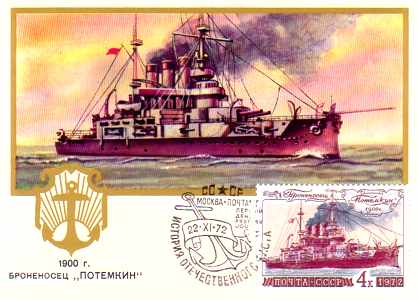
|
Still in the same year the "Potemkin" was pumped out and towed to Odessa.
As punishment she was renamed "Pantelymon", i.e. “Simple Peasant”.
At the beginning of World War I she got another new name, "Borec za Svobodu", i.e. “Fighter for Liberty”.
The ship was involved in various battles against Turkish and German naval units, among others against the
former German battleship "Goeben" renamed "Yavuz Sultan Selim" in 1914.
In 1918 at Sewastopol the old "Potemkin" fell into German hands. In 1919 the retreating German
troops again scuttled the ship to prevent her use by the approaching Soviet troops.
Other sources state that the ship received her former name "Knjas Potjomkin
Tawritscheski" in March 1916, followed by the renaming to "Borec za Svobodu" in May 1917.
In April 1919, British forces operating on the Crimea are said to have destroyed the vessel’s engines.
The ship was broken up between 1923-25.
|
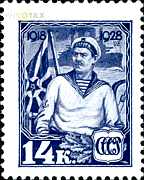
|
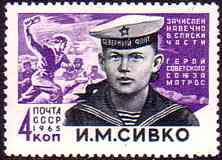
|
What happened to the crew?
Matjusenko, once chairman of the "Potemkin"s Sailors Council, returned to Russia in 1907, trusting to be covered
by an amnesty law passed in the meantime. He was arrested and hung.
Some crew members who had already returned to Russia in 1905 were convicted and imprisoned.
Most of the crew, however, came back to Russia only following the February revolution of 1917.
|
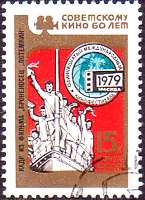
|
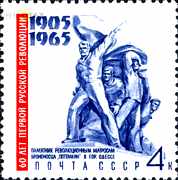
|
The Russian director Sergey M. Eisenstein immortalized this sailor rebellion in 1925.
Arriving at Sewastopol, he could not find any trace of the scrapped "Potemkin".
A rusty hull of a decommissioned cruiser is said to have substituted as the movie set. Others claim the film
was shot on the "Potemkin" proper!
The silent movie "Armored Cruiser Potemkin" premiered Moscow's Bolshoi Theater on
December 21, 1925, as an official anniversary film celebrating the revolution of the year 1905.
The stamp at left shows an "Armored Cruiser Potemkin" movie poster with the
emblem of the 11th Film Festival in Moscow, 1979, in its upper right corner.
The stamp at right shows the monument in Odessa honoring the "Potemkin" sailors.
The prominently enlarged 4 copecks stamp at the beginning of this page shows a scene from the movie where
sailor Vakulincuk exhorts the firing squad not to fire at those refusing the rotten food.
|
Sources:
Winfried Asendorpf: From "Prince" to "Simple Farmer"
Henning Sietz: Mutiny on the "Potjomkin", Mare No. 7
Wikipedia Internet dictionary
Navicula, encyclopedia of the maritime philately.
As already indicated above, available information comes in different versions,
particularly regarding the chronology.
|
|